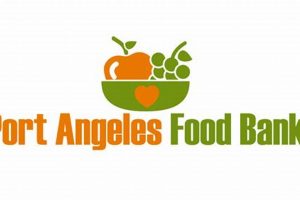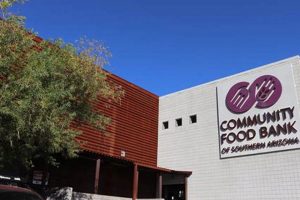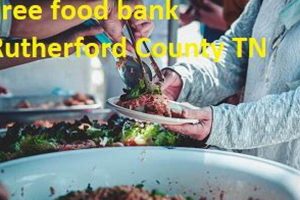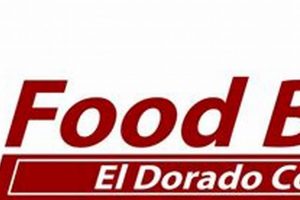Eligibility criteria for accessing resources from charitable food distribution centers vary depending on the specific organization and geographic location. These criteria often consider household income relative to the poverty level, residency within a defined service area, and demonstration of need through documentation such as proof of address or income statements. For instance, a family experiencing temporary unemployment and falling below a certain income threshold might qualify for assistance.
The establishment of such requirements ensures that resources are allocated effectively to individuals and families facing genuine food insecurity. They allow food banks to prioritize those most vulnerable, maximizing the impact of their operations. Historically, these guidelines have evolved in response to changing economic conditions and a growing understanding of the root causes of hunger within communities.
Understanding these access parameters is essential for both prospective recipients and those involved in food bank operations. This article will delve into the common categories of eligibility factors, methods of verification, and the potential challenges faced by individuals seeking assistance, along with information regarding the process for qualification determination.
Successfully meeting the necessary requirements for food assistance requires preparedness and a clear understanding of the process. The following points offer guidance for individuals seeking support.
Tip 1: Research Local Providers: Prior to applying, identify the food banks or pantries serving the specific geographic area. Each organization may have slightly different criteria or specific documentation requests. Contacting them directly or visiting their websites will provide clarity on their requirements.
Tip 2: Gather Necessary Documentation: Prepare all essential documents beforehand. This often includes proof of residency (utility bill, lease agreement), identification (driver’s license, passport), and income verification (pay stubs, benefit statements). Having these readily available will streamline the application process.
Tip 3: Understand Income Thresholds: Be aware of the income limits established by the food bank. These limits are often based on household size and are used to determine eligibility. Familiarize yourself with these figures to assess potential qualification.
Tip 4: Be Prepared to Answer Questions Accurately: During the application or interview process, respond truthfully and accurately to all inquiries. Providing false information can result in denial of assistance and potentially further complications.
Tip 5: Inquire About Alternative Resources: If initial attempts to meet the defined access requirements are unsuccessful, inquire about alternative food assistance programs or resources available in the community. Food banks can often provide referrals to other organizations that may offer assistance.
Tip 6: Maintain Open Communication: Stay in communication with the food bank throughout the application process. If there are any changes in circumstance or if additional documentation is needed, promptly notify the organization. This demonstrates a commitment to responsible resource utilization.
Adhering to these guidelines can significantly improve the chances of successfully meeting the access requirements and receiving needed food assistance. Preparation and open communication are key.
With these tips in mind, the following sections will explore the long-term implications of adhering to food bank guidelines and the broader societal impact of these organizations.
1. Income Verification
Income verification stands as a cornerstone in the determination of access to resources provided by charitable food distribution networks. Its function is to objectively assess financial need, ensuring resources are allocated to those most vulnerable to food insecurity. This process is a crucial component of maintaining the integrity and effectiveness of food assistance programs.
- Pay Stubs as Primary Evidence
Pay stubs serve as a frequent and reliable source of income verification. These documents provide a detailed breakdown of earnings over a specified period. Food banks utilize pay stubs to calculate current income levels, comparing them against pre-defined eligibility thresholds. Irregular or inconsistent pay can complicate this verification process, requiring additional documentation or clarification.
- Benefit Statements for Public Assistance
Individuals receiving public assistance, such as unemployment benefits or Social Security, can provide official benefit statements. These statements outline the amount and frequency of payments received from government sources. Food banks consider these benefits as part of the overall household income assessment, factoring them into the eligibility determination.
- Tax Returns for Self-Employed Individuals
Self-employed individuals often present tax returns as proof of income. Food banks may require the most recent tax return to assess the overall financial standing of the applicant. Given the complexities of self-employment income, deductions and business expenses are carefully reviewed to determine net income for eligibility calculations.
- Affidavits and Declarations in Exceptional Cases
In certain circumstances where traditional documentation is unavailable, affidavits or sworn declarations may be accepted as a substitute. This typically occurs when individuals lack formal income records due to unemployment, informal employment, or other extenuating circumstances. While helpful, those tools may need other records to be effective.
The accuracy and completeness of income verification are paramount to fair and effective allocation of food bank resources. These processes are designed to balance the need for thorough assessment with the goal of minimizing barriers to access for eligible individuals and families facing food insecurity.
2. Residency Requirements
Residency requirements form a fundamental aspect of eligibility criteria for charitable food assistance, directly impacting who receives aid from a particular food bank. These stipulations, often necessitating proof of address within a specific geographic area (e.g., a county, city, or zip code), ensure that a food bank’s resources are allocated to individuals residing within its designated service area. Without residency verification, resources could be dispersed beyond the area the food bank is chartered to serve, potentially depleting resources needed by local residents. As an illustration, a food bank operating within a specific county might require applicants to present a utility bill, lease agreement, or official correspondence displaying their name and address within that county. This process safeguards the food bank’s ability to fulfill its commitment to its immediate community.
The enforcement of residency requirements also aids in preventing resource duplication and fraud. By confirming applicants’ addresses, food banks can cross-reference databases to identify instances where individuals may be attempting to access aid from multiple sources simultaneously, an action that could deprive others in genuine need. Furthermore, residency stipulations contribute to efficient logistical operations. Knowing the geographic distribution of recipients enables food banks to strategically plan distribution routes, allocate resources appropriately, and partner with local organizations to enhance outreach efforts within specific neighborhoods. For instance, a food bank might collaborate with a local church or community center to establish a satellite distribution site in an area with a high concentration of eligible residents.
In summary, residency requirements constitute an essential element of effective food bank administration. They serve as a mechanism for ensuring resource allocation within the intended service area, preventing fraud and duplication, and optimizing logistical operations. While these stipulations may pose challenges for transient populations or those experiencing homelessness, they remain crucial for maintaining the integrity and efficiency of food assistance programs, allowing food banks to prioritize aid to established residents facing food insecurity within their designated communities.
3. Household Size
Household size is a crucial determinant within the spectrum of resource allocation by food banks. It directly influences eligibility and the amount of food assistance an applicant household receives. The logic is straightforward: larger households, with more members dependent on a shared income, face greater budgetary constraints and are at higher risk of food insecurity. Consequently, food banks utilize household size as a primary factor in calculating need and tailoring the support provided. For example, a single individual household may qualify for a smaller food package compared to a household of five, even if both have similar income levels. This differential treatment reflects the understanding that the larger household’s resources must stretch further to meet the nutritional needs of all members.
The use of household size in determining qualification is not without its complexities. Defining “household” can be challenging, particularly in instances of multi-generational families, unrelated individuals sharing housing, or blended families with complex custody arrangements. Food banks must establish clear and consistent guidelines for defining household membership to ensure fair and equitable resource distribution. This definition often relies on a combination of legal relationships (marriage, parent-child) and economic interdependence (sharing of resources). Further, the collection of accurate household size data can be sensitive, requiring food banks to handle personal information with care and respect for applicant privacy. Misrepresentation of household size, either intentional or unintentional, can lead to inaccurate needs assessments and potential misuse of resources.
In summary, household size functions as a fundamental, yet multifaceted, component of eligibility assessments for food assistance. Its accurate assessment and integration into qualification protocols are essential for ensuring that food banks effectively address the varying needs of diverse households facing food insecurity. While challenges exist in defining and verifying household composition, consistent and transparent application of these criteria is crucial for maintaining the integrity and equitable distribution of resources within the charitable food sector.
4. Demonstrated Need
Demonstrated need serves as a critical, often subjective, component within the established criteria for accessing food bank resources. While objective measures like income and household size provide quantifiable metrics, demonstrated need incorporates qualitative factors that capture the realities of food insecurity beyond simple numbers. Its inclusion is meant to ensure that those facing exceptional circumstances or acute crises are not excluded from receiving assistance.
- Hardship Statements
Hardship statements, personal narratives outlining the challenges contributing to food insecurity, are often solicited by food banks. These statements allow applicants to detail situations such as unexpected medical expenses, job loss, or natural disasters that have strained their financial resources. For example, a family whose primary wage earner experienced a sudden, uninsured illness might use a hardship statement to explain their inability to afford both medical care and adequate food supplies. The credibility and clarity of the statement influence its weight in the qualification decision.
- Referrals from Social Service Agencies
Referrals from established social service agencies act as third-party endorsements of an applicant’s need. Case workers or counselors at these agencies can assess an individual or family’s circumstances and provide a referral letter to the food bank, attesting to their vulnerability. A homeless shelter referring a client to a food bank, for instance, provides validation of that individual’s lack of access to regular meals. Such referrals carry significant weight due to the expertise and objectivity of the referring agency.
- Emergency Situations
Food banks often reserve a portion of their resources for individuals and families facing immediate emergencies, such as house fires or displacement due to domestic violence. In these situations, the standard qualification process may be expedited or waived to provide rapid relief. A family displaced by a fire, for instance, might be granted immediate access to food assistance based on verifiable evidence of the disaster, such as a police report or insurance claim.
- Lack of Alternative Resources
Demonstrated need can also encompass a lack of alternative support systems. Applicants may be asked to provide information about whether they have family, friends, or other community resources they can rely on for assistance. Individuals with limited social support networks may be prioritized over those with greater access to informal aid. This facet acknowledges that food insecurity can be exacerbated by social isolation and the absence of a safety net.
These facets of demonstrated need complement objective qualification criteria, creating a more holistic assessment of an applicant’s vulnerability to food insecurity. While incorporating subjective elements adds complexity to the qualification process, it also allows food banks to respond more effectively to individual circumstances and ensure that assistance reaches those most in need, even when standard eligibility metrics may not fully capture their plight. Demonstrated need humanizes the process, acknowledging that numbers alone cannot fully reflect the realities of food insecurity.
5. Documentation Accuracy
Documentation accuracy forms a linchpin in the food bank qualification process, directly influencing the equitable distribution of resources. Inaccurate or falsified documentation can lead to the misallocation of assistance, depriving eligible individuals and families of necessary support. For instance, an applicant misrepresenting income or household size through altered or fabricated documents may unfairly receive benefits, while a legitimately needy individual is denied access due to resource depletion. Therefore, stringent verification processes are vital to ensuring the integrity of the system.
The reliance on accurate documentation extends beyond immediate resource allocation. Data collected from applications and supporting documents is often used to inform broader policy decisions and resource planning within the food bank network. If the data is compromised by inaccuracies, it can lead to misguided strategies and inefficient use of funds. For example, an overestimation of need in a particular area, based on inaccurate documentation, could result in the over-allocation of resources to that area, while other regions with genuine unmet needs are underserved. Furthermore, documentation accuracy is crucial for compliance with regulatory requirements and funding accountability. Many food banks rely on grants and donations, and adherence to strict reporting standards, based on accurate data, is essential for maintaining funding eligibility and public trust.
In conclusion, the integrity of food bank qualifications hinges upon the accuracy and verifiability of applicant documentation. This element is not merely a procedural formality but a fundamental safeguard against resource misallocation and a cornerstone of responsible stewardship within the charitable food sector. Challenges in achieving and maintaining documentation accuracy persist, including the reliance on self-reported information and the potential for fraudulent activity. Addressing these challenges through robust verification processes and ongoing training for both staff and applicants remains paramount to ensuring the effectiveness and fairness of food assistance programs.
Frequently Asked Questions
This section addresses common inquiries concerning the established guidelines for accessing assistance from charitable food distribution organizations.
Question 1: What constitutes valid proof of residency for accessing food bank resources?
Acceptable forms of proof typically include a recent utility bill displaying the applicant’s name and address, a current lease agreement, or official correspondence from a government agency. Specific requirements may vary depending on the food bank’s policies.
Question 2: How is household income verified for eligibility purposes?
Verification often involves providing recent pay stubs, benefit statements from government assistance programs, or tax returns for self-employed individuals. Food banks may also accept sworn affidavits in certain exceptional circumstances where traditional documentation is unavailable.
Question 3: Does household size impact the level of food assistance provided?
Yes, household size is a significant factor in determining the quantity of food distributed. Larger households typically receive more assistance than smaller ones, reflecting the increased nutritional needs of a greater number of individuals.
Question 4: What recourse is available if an application for food assistance is denied?
Applicants who are denied assistance have the right to inquire about the reason for the denial and to appeal the decision if they believe it was made in error. Food banks should provide clear information about their appeal process.
Question 5: How do food banks address the needs of individuals experiencing homelessness?
Food banks often collaborate with homeless shelters and other social service agencies to provide assistance to individuals experiencing homelessness. While traditional residency requirements may be relaxed in these cases, applicants may still need to provide some form of identification or verification of their circumstances.
Question 6: Are there restrictions on the type of food items that can be received from a food bank?
While food banks strive to provide a variety of nutritious options, the availability of specific items may vary depending on donations and inventory levels. Food banks typically prioritize the distribution of shelf-stable items, fresh produce, and protein sources.
These FAQs offer insight into key considerations when attempting to meet the established requirements for assistance. Adherence to these guidelines promotes equitable access for all.
The subsequent section will delve into the long-term societal effects of food banks and their role in mitigating food insecurity.
Food Bank Qualifications
This exploration has detailed the multifaceted nature of the criteria used to determine access to food bank resources. Income verification, residency stipulations, household size considerations, demonstrated need assessments, and the imperative of documentation accuracy all constitute vital components of a system designed to equitably allocate limited resources. The consistent and transparent application of these stipulations is essential for ensuring that assistance reaches those facing genuine food insecurity.
While complexities and challenges persist, ongoing efforts to refine and improve the application process are crucial. A continuous commitment to fair and efficient resource distribution is paramount to maximizing the positive impact of food banks in alleviating food insecurity within communities and promoting societal well-being. Further research and community engagement are needed to address systematic issues and promote food security.







